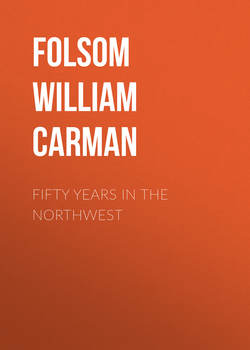Читать книгу Fifty Years In The Northwest - Folsom William Henry Carman - Страница 18
CHAPTER II.
STILLWATER AND ST. CROIX COUNTY
STILLWATER IN 1846
ОглавлениеLiving in Stillwater, Jan. 1, 1846, were the following married men: Cornelius Lyman, Socrates Nelson, Walter R. Vail, Robert Kennedy, Anson Northrup, Albert Harris, John E. Mower, William E. Cove, John Smith, and W. H. C. Folsom. Among the unmarried men were: John McKusick, C. Carli, Jacob Fisher, Elam Greely, Edward Blake, Elias McKean, Calvin F. Leach, Martin Mower, David B. Loomis, Albion Masterman, John Morgan, Phineas Lawrence, Joseph Brewster, John Carlton, Thomas Ramsdell, William Rutherford, William Willim, Charles Macey, and Lemuel Bolles.
Here follows a list of the pioneers of the St. Croix valley, in 1846, not mentioned elsewhere: Nelson Goodenough, who became a river pilot and settled at Montrose, Iowa; James Patten, Hugh McFadden, Edwin Phillips, a millwright, an ingenious, eccentric man, who left the valley in 1848; Joseph Brewster, who left in 1848, and settled in Earlville, Illinois; Sylvester Stateler, blacksmith, who removed to Crow Wing county, Minnesota, and O. H. Blair, who followed lumbering, a man of talent, but eccentric. He died in 1878. The first school was taught in 1846, by Mrs. Ariel Eldridge, formerly Sarah Louisa Judd. The second school was taught in 1847, by Mrs. Greenleaf; the third in 1848, by Wm. McKusick. A school house was built in 1848. Rev. W. T. Boutwell, a Presbyterian minister, preached occasionally in the reception room of Northrup's hotel. Rev. Eleazer Greenleaf, an Episcopalian, came the next summer and established regular services. Prior to the organization of Stillwater, Rev. J. Hurlbut, a Methodist minister, had preached in Dakotah, St. Croix Falls and Marine, but organized no societies.
The winter of 1845-46 was very open. All teaming business was done on wheels, except for a few days in December, in which there was snow enough for sledding. A new feature in the trade of the valley this year was the rafting and running of logs to St. Louis.
In December, 1845, Dr. Borup, of La Pointe, and others went by ice and overland with teams to Prairie du Chien, I accompanying them. The first day we came to Point Douglas, at the confluence of the St. Croix and the Mississippi. Between Stillwater and Point Douglas, on the route we followed, some distance west of the lake, we found but one settler, Joseph Haskell. At Point Douglas there were David Hone, a hotel keeper; Hertzell & Burris, merchants, and Wm. B. Dibble, farmer. We reached Red Wing the second day. At this place lived the famous Jack Frazier, a Sioux half-breed and Indian trader, one Presbyterian missionary, Rev. – Denton, and a man named Bush. James Wells, more familiarly known as "Bully Wells," lived with an Indian squaw on the west shore of Lake Pepin, where stands the town of Frontenac. On the third day we went as far as Wabasha, on the west side, three miles below Lake Pepin, where we found several French families. We stopped at Cratt's hotel. On the fourth day we reached Holmes' Landing, now Fountain City. There were then but two houses, both unoccupied. About noon we passed Wabasha prairie, now the site of Winona. It was then covered with Indian tepees. At Trempealeau, in the evening of the fifth day, we found two French families. On the next day we reached La Crosse and found there two American families. Two days more brought us to Prairie du Chien. On the way we passed a few French families, and these, with those previously named, constituted the entire white population between Stillwater and Prairie du Chien.
We started on our return with four two horse teams. We took the river road, passing over the ice. In our company was one Tibbetts, from Fort Crawford, and Jonathan E. McKusick, emigrating from Maine to St. Croix valley. They were a social, jovial pair. At Capilaux bluff, Dibble's team was ahead, and my team second. At this place all halted to allow the thirsty an opportunity of liquoring up, which was done at the rear team. Dibble, in going back, left his team unfastened, and while he was "smiling" with his jovial companions the team ran away. The horses soon broke loose from the sled. One horse made for the shore, the other plunged into an air hole in the ice. The entire company rushed to the rescue, and with ropes and poles managed, at last, to float the horse upon the ice in an unconscious condition. All the whisky left by the "smiling" throng was poured down the horse's throat, but in vain. The animal was dead. No other event of interest occurred except some difficulties experienced in the transportation of the first cat ever brought to Stillwater. "Tom" was caged in a narrow box, and the confinement so chafed his proud spirit that he sickened and at one time was reported dead. At the inquest held over his remains by Capt. McKusick, signs of life were discovered, and by liberal blood-letting the cat was restored to consciousness and lived several years afterward, a terror to the rats in Stillwater.
